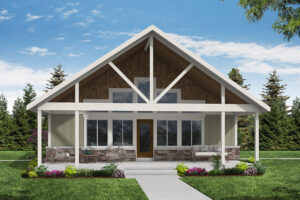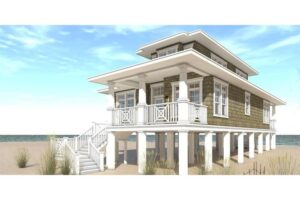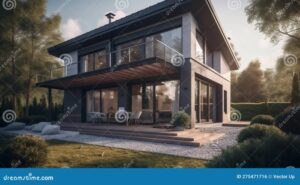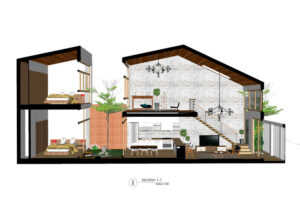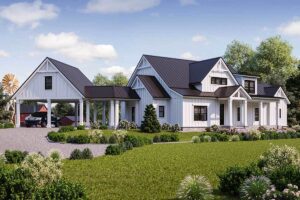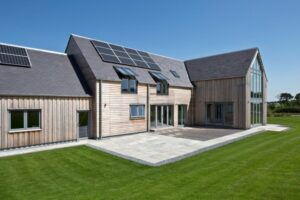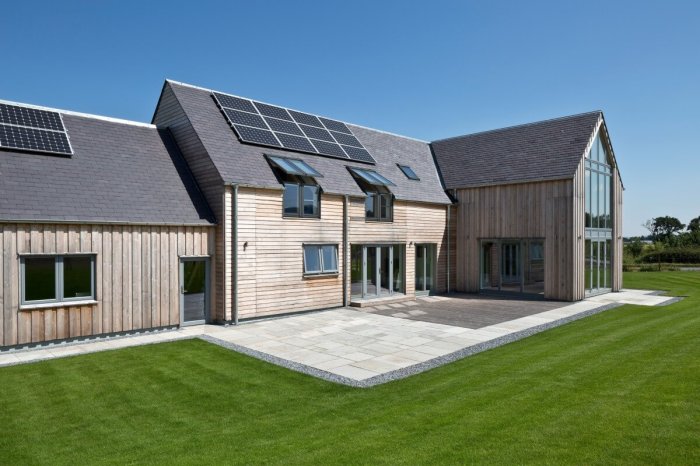
Exploring Energy-efficient house designs opens a window into the future of sustainable living, where eco-conscious decisions meet modern aesthetics. These designs not only aim to reduce energy consumption but also enhance comfort, health, and overall quality of life. By integrating smart strategies and innovative materials, energy-efficient homes are transforming the way we think about residential architecture.
From optimizing orientation for natural light to selecting sustainable furniture, every aspect contributes to a greener lifestyle. Homeowners are encouraged to embrace practices that not only benefit the planet but also promote a healthier indoor environment.
Energy-efficient House Design Principles
Energy-efficient house designs are rooted in principles that prioritize sustainability, comfort, and cost-effectiveness. These principles guide architects and builders in creating homes that not only reduce environmental impact but also lower energy bills for homeowners. By focusing on the design and materials used, energy efficiency becomes a fundamental aspect of modern housing.The core principles of energy-efficient house designs include passive solar heating, thermal mass, proper insulation, and the use of renewable energy sources.
Each of these elements plays a crucial role in minimizing energy consumption while maximizing comfort.
Orientation and Layout Impact on Energy Efficiency
The orientation and layout of a house are vital in maximizing energy efficiency. By strategically positioning a house, builders can harness natural elements such as sunlight, wind, and shade, significantly reducing reliance on artificial heating and cooling systems.
1. Sunlight Exposure
Homes oriented to face south (in the Northern Hemisphere) can capture the most sunlight throughout the day, enhancing passive solar heating.
2. Natural Ventilation
A layout that promotes cross-ventilation allows for natural cooling, reducing the need for air conditioning.
3. Wind Protection
Strategically placed trees or buildings can shield a home from harsh winds, maintaining a more stable indoor temperature.By considering these factors during the design phase, energy-efficient homes can achieve lower energy usage levels, resulting in long-term savings.
Materials Enhancing Energy Efficiency
The choice of materials in home construction plays a significant role in energy efficiency. Selecting the right materials can improve insulation, reduce air leaks, and enhance the overall energy performance of a building. Common materials that enhance energy efficiency include:
Insulation Materials
High-quality insulation, such as spray foam or cellulose, prevents heat transfer and keeps indoor temperatures stable.
Energy-efficient Windows
Double or triple-pane windows with low-emissivity coatings minimize heat loss and gain, improving comfort levels.
Sustainable Building Materials
Using recycled or sustainably sourced materials, like bamboo or reclaimed wood, reduces environmental impact and often provides better thermal performance.Implementing these materials not only aids in energy conservation but also creates a healthier living environment by reducing the carbon footprint of a home.
By integrating thoughtful design and high-performance materials, energy-efficient homes can significantly reduce energy consumption while providing a comfortable living space.
Sustainable Home Furniture
Selecting sustainable furniture is an essential aspect of creating an energy-efficient home. The right choices not only reduce environmental impact but also enhance the overall aesthetic and functionality of living spaces. Sustainable materials, thoughtful design, and multifunctional pieces contribute significantly to the sustainability goals of any home. The significance of furniture design in energy-efficient homes cannot be overstated. Well-designed furniture helps optimize space and can contribute to better airflow and natural light, which are integral to minimizing energy consumption.
Choosing the right materials and designs can also influence indoor air quality and overall comfort.
Selection of Sustainable Materials for Home Furniture
When choosing sustainable materials, it’s important to focus on renewable resources and environmentally friendly practices. Below are key materials and considerations that promote sustainability in furniture design:
- Bamboo: Fast-growing and highly renewable, bamboo is a great alternative to hardwood. It boasts strength and durability while reducing deforestation impact.
- Reclaimed Wood: Using wood from old buildings or furniture minimizes waste and lowers carbon emissions associated with producing new materials.
- Recycled Metal: Metals that have been recycled require less energy to process and contribute to reducing waste.
- Organic Fabrics: Fabrics made from organic cotton, hemp, or linen are grown without harmful pesticides and chemicals, making them safer for both the environment and health.
- Low-VOC Finishes: Volatile organic compounds (VOCs) are harmful to indoor air quality. Selecting furniture with low-VOC finishes helps maintain a healthier living space.
Importance of Furniture Design in Energy-Efficient Homes
The design of furniture plays a critical role in enhancing energy efficiency in homes. Thoughtfully designed furniture not only occupies less space but can also improve the overall functionality of a room.
“Smart furniture design promotes better airflow and natural light, leading to reduced energy consumption.”
Key aspects of furniture design that contribute to energy efficiency include:
- Space Optimization: Compact furniture arrangements can minimize clutter and maximize usable space, facilitating better movement and energy flow throughout the home.
- Natural Light Utilization: Furniture placement can be optimized to allow more natural light into living spaces, reducing the need for artificial lighting during the day.
- Use of Color: Lighter colors can reflect light, enhancing brightness in a room and further decreasing the reliance on electric lighting.
Examples of Multifunctional Furniture
Multifunctional furniture is essential in energy-efficient homes, as it maximizes utility while minimizing space. Here are some noteworthy examples:
- Sofa Beds: A combination of seating and sleeping areas, sofa beds are ideal for small apartments and guest accommodations.
- Storage Ottomans: These versatile pieces serve as footrests, extra seating, and storage solutions, helping to reduce the number of individual furniture items needed.
- Expandable Dining Tables: Perfect for small dining areas, these tables can be adjusted to accommodate more guests when necessary, offering flexibility without sacrificing space.
- Wall-Mounted Desks: Desks that can be folded away when not in use save space and maintain an uncluttered environment in home offices or study areas.
- Bunk Beds: Ideal for maximizing sleeping space in shared rooms, bunk beds free up floor space for other activities.
Green Living Practices
Adopting green living practices in your household can significantly reduce your environmental footprint while enhancing your overall quality of life. Simple adjustments to daily routines and mindful choices in design can lead to a more sustainable way of living. Here, we explore some actionable steps that homeowners can take, along with the vital role of indoor plants and the advantages of minimizing waste in our homes.
Daily Practices for a Greener Lifestyle
Implementing eco-friendly habits doesn’t require a complete lifestyle overhaul; small changes can make a big impact. Here are some effective daily practices that promote sustainability:
- Utilizing energy-efficient appliances reduces electricity consumption and lowers utility bills.
- Switching to LED lighting can save up to 80% more energy compared to traditional bulbs.
- Adopting a plant-based diet, even partially, can significantly decrease water usage and carbon emissions.
- Using reusable shopping bags, water bottles, and containers helps cut down on single-use plastic waste.
- Composting organic waste transforms kitchen scraps into nutrient-rich soil, reducing landfill contributions.
The Role of Indoor Plants in Energy Efficiency and Air Quality
Indoor plants not only beautify a space but also contribute significantly to energy efficiency and improved air quality. They can help regulate humidity levels and filter harmful toxins from the air, making them essential for a healthy indoor environment. Some popular choices include:
- Spider plants, known for their air-purifying properties, can remove pollutants such as formaldehyde and xylene.
- Peace lilies are effective in absorbing excess moisture, which can help reduce reliance on air conditioning.
- Snake plants are unique in that they convert CO2 into oxygen at night, improving air quality while you sleep.
The inclusion of houseplants can also provide psychological benefits, aiding in stress reduction and enhancing overall well-being.
Benefits of Reducing Waste in Home Design and Lifestyle
A commitment to reducing waste is pivotal in fostering a sustainable living environment. This can be achieved through thoughtful home design choices and lifestyle adjustments. Here are some benefits associated with reducing waste:
- Lower environmental impact through minimized landfill waste and reduced consumption of resources.
- Cost savings achieved by reusing items, choosing durable materials, and investing in quality over quantity.
- Enhanced aesthetic appeal as homes become more organized and clutter-free through intentional design choices.
- Promotion of a circular economy by choosing products made from recycled materials, ensuring resources are reused.
The principles of reducing waste can extend beyond the home and influence broader community practices, creating a more sustainable future for everyone.
Heating and Air Conditioning Solutions
Choosing energy-efficient heating and air conditioning solutions is essential for creating a comfortable and sustainable living environment. By integrating advanced technologies and proper insulation, homeowners can significantly reduce their energy consumption while maintaining optimal indoor air quality. In this section, we will explore various heating and cooling systems, the critical role of insulation, and how smart thermostats can enhance energy savings.
Energy-efficient Heating and Cooling Systems
When selecting energy-efficient heating and cooling systems, it is important to consider several options that can cater to different needs and preferences. Below are some prevalent systems that stand out for their efficiency and environmental benefits:
- Heat Pumps: These systems transfer heat rather than generate it, making them highly efficient. Air-source heat pumps can provide both heating and cooling, while ground-source (geothermal) systems offer even greater efficiency by utilizing stable underground temperatures.
- High-Efficiency Furnaces: Furnaces with an Annual Fuel Utilization Efficiency (AFUE) rating of 90% or higher convert most of the fuel they consume into heat, reducing energy waste.
- Solar Heating Systems: By using solar collectors, these systems harness energy from the sun to heat water or air, significantly lowering reliance on conventional energy sources.
- Ductless Mini-Split Systems: These offer flexible zoning capabilities, allowing for targeted heating and cooling in specific areas of a home, which optimizes energy use.
Importance of Proper Insulation
Proper insulation is a cornerstone of energy-efficient homes, as it minimizes the amount of energy required to maintain comfortable indoor temperatures. Adequate insulation reduces heat loss in winter and prevents heat gain in summer, which directly impacts energy consumption. Here are key benefits of effective insulation:
- Enhanced Comfort: Insulation creates a stable indoor environment, reducing drafts and temperature fluctuations for a more comfortable living space throughout the year.
- Lower Energy Bills: By keeping conditioned air inside, insulation can lead to a noticeable decrease in heating and cooling expenses, making it a cost-effective investment over time.
- Environmental Impact: Proper insulation contributes to lower greenhouse gas emissions, supporting a more sustainable lifestyle and reducing the carbon footprint of the home.
Impact of Smart Thermostats
Smart thermostats are revolutionizing the way homeowners control their heating and cooling systems, leading to significant energy savings. These devices allow users to set schedules, monitor energy consumption, and even adjust settings remotely via smartphone apps. The benefits of smart thermostats include:
- Energy Usage Optimization: By learning the homeowner’s habits, smart thermostats can automatically adjust temperatures to suit occupancy patterns, reducing energy waste when spaces are unoccupied.
- Energy Reports: Many smart thermostats provide insights into energy usage, helping homeowners identify trends and areas for improvement in their energy consumption.
- Integration with Other Smart Devices: These thermostats can easily integrate with other home automation systems, further enhancing energy efficiency by coordinating various devices for optimal performance.
The combination of advanced heating and cooling systems, effective insulation, and smart technology empowers homeowners to create energy-efficient spaces that are both comfortable and environmentally friendly.
Home Inspections for Energy Efficiency

Conducting a home inspection for energy efficiency is a critical step in identifying areas where energy consumption can be reduced, leading to lower utility bills and a more sustainable living environment. Effective inspections can uncover hidden issues that, if addressed, can significantly enhance a home’s overall energy performance. This section delves into important aspects of energy efficiency inspections, providing a detailed checklist, common issues to watch for, and methods for improvement based on inspection findings.
Energy Efficiency Inspection Checklist
An energy efficiency inspection checklist serves as a vital tool for homeowners and inspectors alike to ensure all areas of the home are examined thoroughly. This checklist can help identify inefficiencies and prioritize improvements for better energy performance. Key components include:
- Inspect insulation levels in attics, walls, and basements.
- Evaluate windows and doors for weather stripping, sealing, and UV protection.
- Check heating and cooling systems for maintenance and efficiency ratings.
- Examine appliances for Energy Star ratings or similar certifications.
- Assess lighting, including the use of LED bulbs and smart lighting systems.
- Review thermostat settings and programmable features for optimal control.
- Inspect the home’s air ducts for leaks, blockages, or inefficiencies.
Common Issues Found During Energy Efficiency Inspections
Certain issues frequently arise during energy efficiency inspections, and recognizing these can significantly improve the effectiveness of remedial actions. Addressing common problems can lead to immediate energy savings and improved comfort levels. Typical issues include:
- Poor insulation, leading to heat loss in winter and heat gain in summer.
- Drafty windows that allow outdoor air to infiltrate the home.
- Unsealed gaps around doors and windows, contributing to air leakage.
- Outdated heating and cooling systems that operate inefficiently.
- Inefficient appliances that consume more energy than necessary.
- Inadequate ventilation causing indoor air quality issues.
Methods for Improving Energy Performance
Based on inspection results, various methods can be implemented to enhance energy performance in a home. These improvements can vary in complexity and cost but often yield significant long-term benefits. Strategies include:
- Upgrading insulation to meet or exceed local building codes.
- Installing energy-efficient windows and doors or adding storm windows.
- Sealing gaps and leaks with caulk or weather stripping to reduce air infiltration.
- Investing in a high-efficiency HVAC system with regular maintenance.
- Switching to Energy Star-rated appliances and fixtures.
- Implementing smart home technology to optimize energy usage.
Innovative House Plans
Innovative house plans prioritize energy efficiency while incorporating modern design principles. These plans not only reduce energy consumption but also create comfortable living spaces that blend seamlessly with their surroundings. By focusing on energy-efficient elements, homeowners can save on utility costs and contribute to a sustainable future.The orientation of a house plan plays a crucial role in maximizing natural light, which in turn enhances energy efficiency.
By strategically positioning windows and living spaces, homeowners can utilize sunlight for heating and illumination, reducing the need for artificial lighting and heating.
Sample Energy-Efficient House Plan
An exemplary energy-efficient house plan features an open-concept layout that promotes airflow and maximizes light. Imagine a single-story home with large south-facing windows that capture the sun’s rays during the day. The walls are made of insulated concrete forms (ICFs), which provide superior thermal performance. A green roof planted with native vegetation adds insulation and reduces stormwater runoff.In the layout, the living room and kitchen are oriented towards the south, while bedrooms are positioned on the north side to maintain cooler temperatures during summer months.
This design effectively utilizes passive solar heating, keeping the home warm in winter and cool in summer.
House Plan Orientation for Natural Light
Orientation is key to ensuring that a home harnesses natural light throughout the day. A well-oriented house will have its longest side facing south, allowing for maximum sunlight exposure. This design not only brightens the interior spaces but also reduces reliance on artificial lighting, significantly lowering energy costs.Consider the following benefits of optimal house orientation:
- Reduced Heating Costs: Sunlight entering the home during winter warms the interior, mitigating the need for additional heating sources.
- Enhanced Daylighting: Strategically placed windows provide abundant daylight, improving mood and productivity while minimizing electricity usage.
- Passive Cooling: Proper eaves and shading can prevent excessive heat gain during summer months, maintaining a comfortable indoor environment.
Modular Designs that Enhance Energy-Saving Features
Modular designs are increasingly popular in energy-efficient housing due to their flexibility and reduced waste during construction. By utilizing pre-fabricated sections, builders can create homes that are not only efficient but also customizable to the homeowner’s needs.Examples of energy-saving features in modular designs include:
- High-Performance Insulation: Modular homes can be built with advanced insulation materials that exceed standard building codes, significantly improving thermal efficiency.
- Smart Home Technology: Integrated systems for monitoring energy usage allow homeowners to track and optimize their energy consumption, leading to further savings.
- Rainwater Harvesting Systems: Many modular designs incorporate systems for capturing and reusing rainwater, which conserves water and reduces utility costs.
In innovative house plans, the integration of these energy-efficient strategies demonstrates a commitment to sustainability, leading to a promising future for eco-friendly living.
Last Point
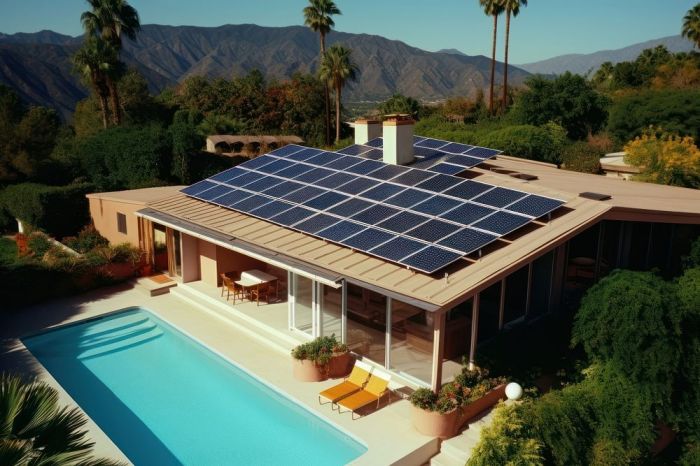
In summary, adopting Energy-efficient house designs is more than just a trend; it represents a significant shift towards more responsible living. As we face pressing environmental challenges, these designs provide practical solutions that can be tailored to any home. By prioritizing sustainable materials, innovative technologies, and mindful living practices, we can create spaces that are not only energy-efficient but also inviting and harmonious with nature.
Clarifying Questions
What are the benefits of energy-efficient house designs?
Energy-efficient house designs reduce utility bills, improve comfort, and decrease the environmental impact of homes.
How can I improve the energy efficiency of my existing home?
Consider upgrading insulation, installing energy-efficient windows, and using smart thermostats to enhance your home’s efficiency.
What role do indoor plants play in energy-efficient homes?
Indoor plants improve air quality and contribute to a healthier living environment, making homes more pleasant and energy-efficient.
Are energy-efficient homes more expensive to build?
While initially investment may be higher, energy-efficient homes typically save money in the long run through lower energy costs.
What are some common features of energy-efficient house designs?
Common features include passive solar design, high-performance insulation, energy-efficient appliances, and renewable energy systems.
